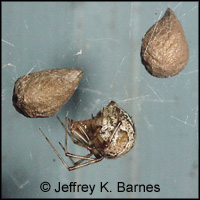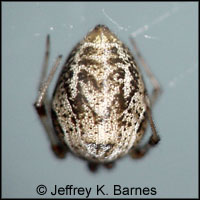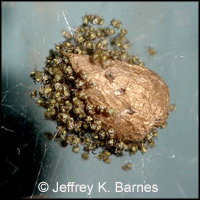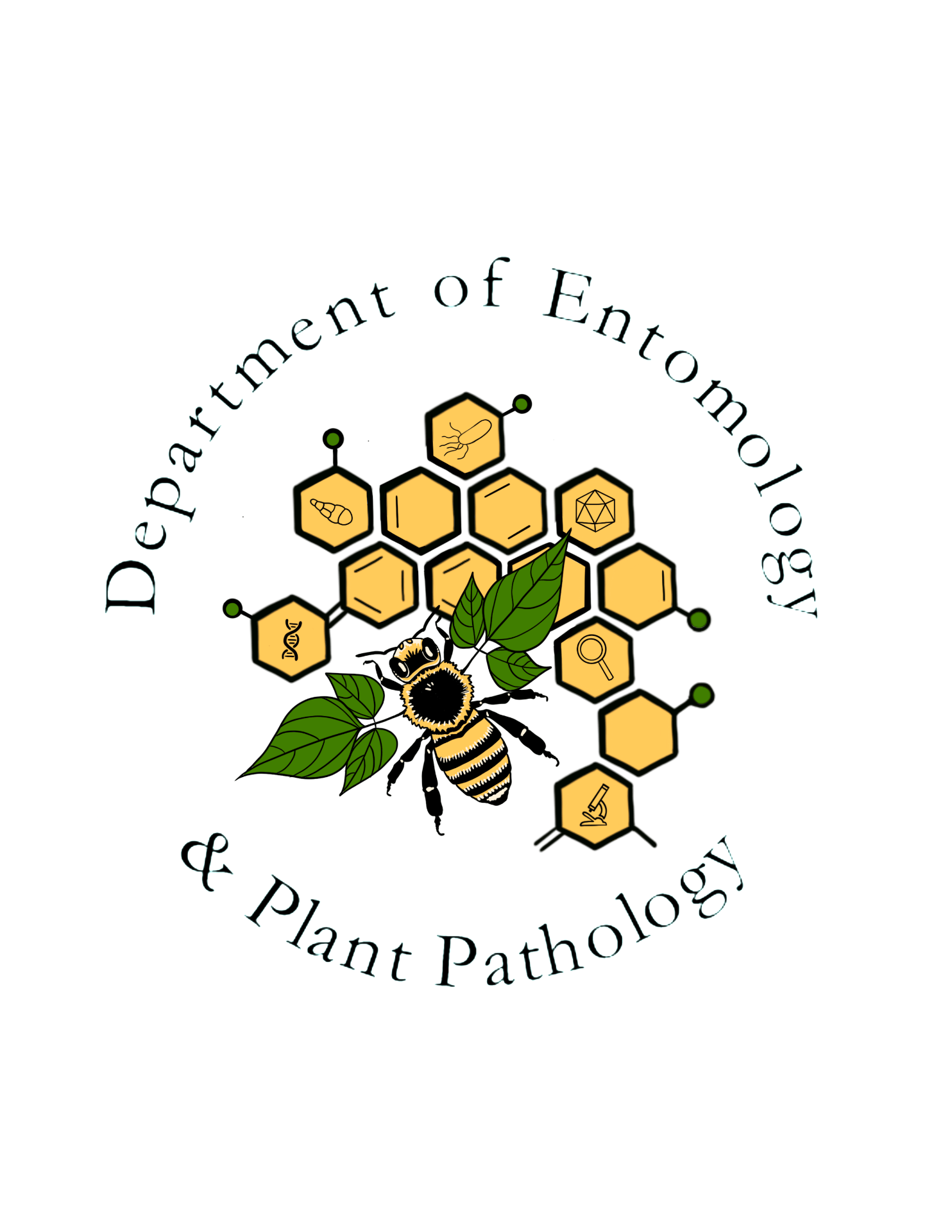Common house spider
Order: Araneae
Family: Theridiidae
Genus and species: Achaearanea tepidariorum (C. L. Koch)




This very common household spider would be inconspicuous if it were not for its persistent and unseemly webs. Many of the dusty cobwebs hanging from corners of neglected ceilings are remnants of this species’ work. The body of the female is up to ¼ inch in length; that of the male is considerably smaller. The cephalothorax is brown dusted with black. The white or light yellow legs have brown and gray apical annulations on most segments, and there are additional annulations at midlength on the first and second pairs of tibiae. The abdomen of the female is high and inflated, and near its highest point posteriorly there is a dark spot surrounded by light and dark U- or V-shaped markings. The abdomen is otherwise light tan and gray with white speckles.
This species has a cosmopolitan distribution and has probably been transported around the world by man. It is abundant in the United States, Mexico, and Central America, and it may be native to South America (Levi 1963). Individuals live a year or more and adults are found in all seasons. This species is rarely found in natural communities except for caves and dry, overhanging rock ledges (Beck and Dorris 1982, Hodge and Storfer-Isser 1997; McDaniel et al. 1979). It is found in many kinds of artificial communities, such as fields and roadsides, farmyards, gardens, vacant lots, cemeteries, and man-made structures (Archer 1946). It is a common and characteristic species of houses, barns, and sheds, often found near outdoor light fixtures. Indoors, house spiders are most likely to be found in humid areas such as basements, crawlspaces, and porches.
The irregular, tangled cobwebs are typically hung in situations that afford overhead shelter. The spider often rests in a retreat within the web. Sites for webs are chosen randomly. Webs that do not yield adequate prey are soon abandoned, and these become littered with dust and debris. Suitable sites with plentiful prey are systematically filled with webbing (Turnbull 1964). Spiders often build webs in areas to which air currents direct prey. Prey consists chiefly of flying insects and other arthropods, including some that are much larger than the spider. In fact, the common house spider is well known for its ability to overpower relatively large prey. Remains of spider wasps, large flies, such as calliphorids and tabanids, beetles, cockroaches, leafhoppers, and harvestmen have been found under webs (Fitch 1963). The common house spider has even been known to feed upon lone star ticks (Archer 1946, Guarisco 1991) and purseweb spiders (Guarisco 1988).
Common house spiders tend to form aggregated populations. Females typically build webs in close proximity to each other, and webs of different individuals are often attached (Hodge and Storfer-Isser 1997). However, females are incompatible, and if they should come into contact one may become prey to the other. Males and females may share the same web for long periods, hanging upside down from the silken threads. The light brown, pear-shaped eggs sacs are produced from late spring to late summer. They hang freely in the web, and each may contain from 100 to 600 or more eggs (Kaston 1981, Miyashita 1987). The sacs have a tough, papery covering and measure up to ¼ inch or more in diameter. A single female can produce many of them during one season. The first instar spiderlings do not feed. Second instars remain in the sac for several days, feeding on undeveloped eggs. These spiderlings emerge and float away on silken threads caught by air currents (Valerio 1974, 1977). This aeronautic behavior is called ballooning, and it is a characteristic means of dispersion in most spider species. The floating spiderlings establish populations in new habitats.
Rarely have common house spiders been known to bite humans, and their bites apparently do not result in serious symptoms, such as local ulcers, necrosis, or serious systemic symptoms (White et al. 1989).
References:
Archer, A. F. 1946. The Theridiidae or comb-footed spiders of Alabama. Alabama Museum of Natural History Museum Paper 22: 67 pages.
Beck, M. L., and P. R. Dorris. 1982. A continuation of spider research in Arkansas: East Central Ozark Mountain area. Proceedings of the Arkansas Academy of Science 36: 20-22.
Fitch, H. S. 1963. Spiders of the University of Kansas Natural History Reservation and Rockefeller Experimental Tract. University of Kansas Museum of Natural History, Lawrence. 202 pages.
Guarisco, H. 1988. Predation of Achaearanea tepidariorum (Araneae, Theridiidae) upon Sphodros fitchi (Araneae, Atypidae). Journal of Arachnology 16: 390-391.
Guarisco, H. 1991. Predation of two common house spiders upon medically significant pests. Transactions of the Kansas Academy of Science 94 (1-2): 79-81.
Hodge, M. A., and A. Strofer-Isser. 1997. Conspecific and heterospecific attraction: a mechanism of web-site selection leading to aggregation formation by web-building spiders. Ethology 103: 815-826.
Kaston, B. J. 1981. Spiders of Connecticut. State Geological and Natural History Survey of Connecticut, Department of Environmental Protection Bulletin 70: 1020 pages.
Levi, H. W. 1963. American spiders of the genus Achaearanea and the new genus Echinotheridion (Araneae, Theridiidae). Bulletin of the Museum of Comparative Zoology 129 (3): 187-240.
McDaniel, V. R., K. N. Paige, and C. R. Tumlison. 1979. Cave fauna of Arkansas: additional invertebrate and vertebrate records. Proceedings of the Arkansas Academy of Science 33: 84-85.
Miyashita, K. 1987. Egg production of Achaearanea tepidariorum (C. L. Koch) (Araneae, Theridiidae) in the filed in Japan. Journal of Arachnology 15: 130-132.
Turnbull, A. L. 1964. The search for prey by a web-building spider Achaearanea tepidariorum (C. L. Koch) (Araneae, Theridiidae). Canadian Entomologist 96: 568-579.
Valerio, C. E. 1974. Feeding on eggs by spiderlings of Achaearanea tepidariorum (C. L. Koch) (Araneae, Theridiidae), and the significance of the quiescent instar in spiders. Journal of Arachnology 2 (1): 57-63.
Valerio, C. E. 1977. Population structure in the spider Achaearanea tepidariorum (Araneae, Theridiidae). Journal of Arachnology 3: 185-190.
White, J., D. Hirst, and E. Hender. 1989. 36 cases of bites by spiders, including the white-tailed spider, Lampona cylindrata. Medical Journal of Australia 150 (7): 401-403.
